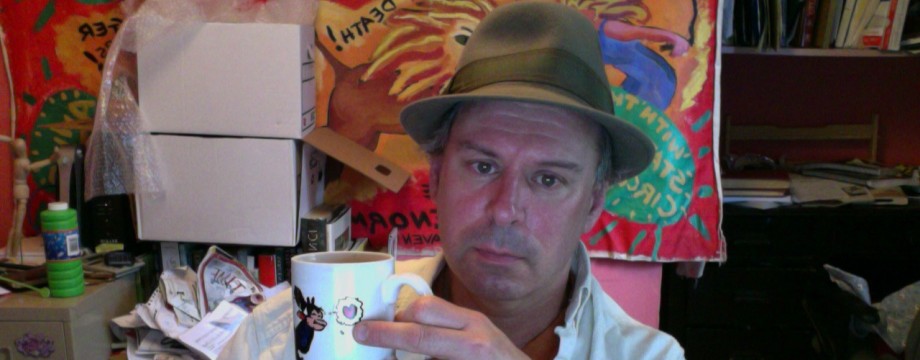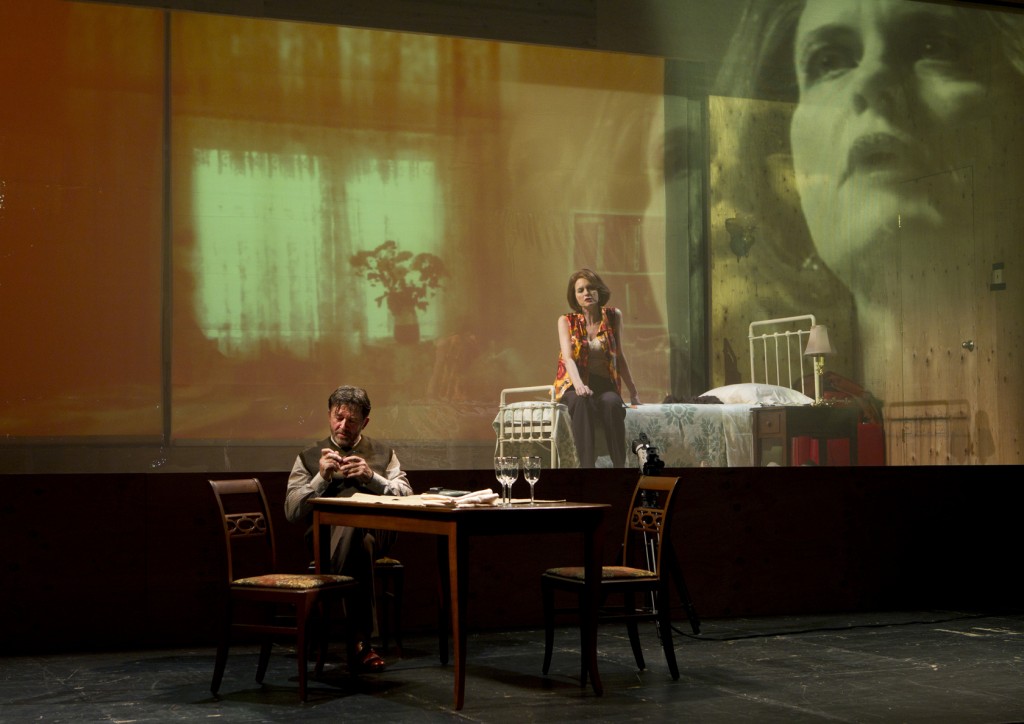PHOTO OF AUTUMN SONATA AT YALE REPERTORY THEATER BY JOAN MARCUS.
Autumn Sonata
Through May 7 at the Yale Repertory Theatre, corner of Chapel and York streets, New Haven.
By Ingmar Bergman. Directed by Robert Woodruff. Based on a literal translation by Wendy Weckworth. Original music by Michael Attias (also Music Director). Scenic designer: Riccardo Hernandez. Costume designer: Candice Donnelly. Lighting designer: Jennifer Tipton. Sound designer: Chad Raines. Projection designer: Peter Nigrini. Production dramaturgs: Amy Boratko, Hannah Rae Montgomery. Vocal coach: Walton Wilson. Stage manager: Lindsey Turteltaub.
Autumn Sonata may be an Ingmar Bergman film. But it’s also now a Robert Woodruff stage production, with its own unique tone, measures and merits.
Adapting a film which has only four main characters, a basic household setting and a lot of back-and-forth arguing is, on one hand, a no-brainer. The film has the dimensions of a play, so it can be a play. But director Woodruff has done considerably more than turn a screenplay into stage blocking. He’s opened up its story of a fraught mother/daughter relationship in ways which Bergman (a transcendent stage director himself) couldn’t in a movie.
The story is simple. Charlotte (played by Candy Buckley, whose cool Off Broadway credits range from The Petrified Prince to Funnyhouse of a Negro) is an internationally celebrated concert pianist whose romantic partner recently died. She visits her daughter Eva (Rebecca Henderson), Eva’s husband Viktor (whom NY Public Theater veteran Olek Krupa plays with a patrician gruffness) and—a revelation to her—her other daughter Helena (Merritt Janson—see my interview with her elsewhere on this site), who’s been in the care of Eva and Viktor for years. The main thrust of the drama is how Eva and Charlotte get along—first trying to appease each other, then ultimately opening up with all sorts of hurtful accusations.
On film, these simmering expressions are handled with lots of close-ups and reaction shots. There aren’t a lot of movie precedents for this sort of dialogue, unless adapted from plays or books. Onstage, Bergman’s text plays comfortably like an O’Neill or Strindberg drama, or Marsha Norman’s ‘Night, Mother, or even Neil Simon’s The Gingerbread Lady if you want to stretch a point. Even laden with Woodruff’s technical wizardry and post-modern sensibility, this is stage drama we instinctively relate to. Autumn Sonata’s confessions and confrontations are modulated and emphasized not by cinematography or editing but by full-bodied acting. They’re Bergman’s words (translated, naturally—Wendy Weckwerth did the honors), but you appreciate the drama anew.
Woodruff magically maintains the filmic qualities of Bergman’s work—projected photo montages, harsh video-camera close-ups, soundtrack music that purposefully obliterates the actors’ dialogue—while simultaneously demonstrating the script’s value as live theater. Technically complex as it might be (the onstage crew get to take a curtain call along with the cast), this is a warm and vibrant and human production. There are emotional expressions of frailty and vulnerability all through it.
Both Bergman and Woodruff distance us from purer emotions through the overt use of camera angles (the sparse stage has several video cameras stationed around its central enclosed rectangular stage area), spatial relationships, color (or in the case of Woodruff, lack thereof—the screen projections and unpainted sets may give you the mistaken impression that the Bergman film was in black & white, when in fact it’s bright and rosy-hued) and particularly the use of music.
Despite some careful dramaturgy—Woodruff commissioned a literal translation of the film dialogue and also consulted the original screenplay and various subtitled versions—a few lines in the drama still come off clunky and unnatural. You may find, however, when you discuss the play afterward (and this is a play that demands such discussion—just plan in advance to hit a bar or coffeeshop before you go home), that the bits which you mihgt think are over-the-top or especially awkward will not jibe with those of other Repgoers. Depending on such personal perspectives as your own childhood relationship with your parents, or your experience with the physically and mentally challenged, or your gender, you may dismiss whole scenes as too much. Bergman does steer into some hoary stereotypes of dominating mothers and long-suffering, finally outspoken daughters:
Because you never listen. Because you’re a goddam escapist, because you actually hate me and Helena, because you are helplessly trapped in yourself, because you’re always in your own way, because you carried me in your cold womb and thrust me out with loathing, because I loved you, because you thought I was disgusting and stupid and a failure.
But beneath those peaks of unbelievability (wherever you might think they are), there are mountains of careful psychological character study that you can’t dispute.
Autumn Sonata isn’t just about mother/daughter relations. It’s about communication and mental balance and the ways we choose to escape through art. All the female characters (mother Charlotte, daughters Eva and Helena) play piano, while Eva’s husband Viktor is a pastor with both a practical and a poetic side. In many scenes, the music speaks more loudly than the dialogue. There’s a tense recital where we see Charlotte judging Eva’s playing while pretending not to. Charlotte’s other daughter, the wheelchair-bound Helena, finds full dreamlike expression behind the keyboard. The cast members, who immediately assert themselves as NOT aping the performances of Ingrid Bergman, Liv Ullmann, Lena Nyman, Halvar Bjork and Georg Lokkeberg in the movie—operate on two planes, as easily bruised flesh-and-blood family and as easily transported musicians and dreamers. Impressively, each performer has a different spiritual center, different extremes, from the cold-to-vivacious swings of Candy Buckley to the flailing-to-fragile contortions of Merritt Janson to the tone-setting subdued-to-overwrought carthartics of Rebecca Henderson.
Actually seeing these women play the piano, hearing the reverberations of actual onstage instruments (including occasional cello accompaniment by Paul Brantley in the flashback role of Charlotte’s deceased romantic partner Leonardo), gives the Yale Rep production an honesty and majesty that distinguishes it from Bergman’s film. The onstage performance of soul-stirring works by Bach and Chopin is enhanced by a bracing new background score by Michael Attias, who had a hand in Woodruff’s previous two Yale Rep projects.
Attias isn’t the only designer perfectly attuned to the disparate needs of Bergman, Woodruff and the tricky Rep venue. Yale can bring resources and understanding to this project that few other theaters could. The Yale School of Drama is on the forefront of sound design (managed here by soon-to-graduate student Chad Raines, who’s performed on Yale stages himself as an actor, musician and Foley Artist) and projection design (entrusted for this show to established Peter Nigrini, though the YSD now has a groundbreaking program in projection design and uses that artform frequently in school shows). Jennifer Tipton, the only lighting designer I can imagine being able to pull off such a challenge as this (The set’s a box! With white screens all around! And tall cameras which you don’t want throwing shadows!), teaches at Yale. Most crucially, so now does Robert Woodruff, who has turned the Rep into an experimental laboratory where in recent seasons he has distilled manic Dostoevsky (Notes from Underground, with Bill Camp), combative Bernard-Marie Koltes (Battle of Black and Dogs) and this achingly beautiful, battle-weary Autumn Sonata. For a show about asserting oneself, you couldn’t ask for a better set of circumstances.


Kitchen Knobs Clearance http://bioex.es/images/news/d646cf1dd2f245fea1b9d6a044a28aa3.asp
Nice post. I learn something more difficult on distinct blogs everyday. Most commonly it is stimulating to learn content using their company writers and employ a little from their site. I’d prefer to apply certain while using content on my small weblog regardless of whether you don’t mind. Natually I’ll offer you a link for your web weblog. Many thanks sharing.